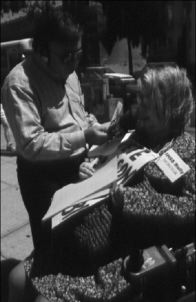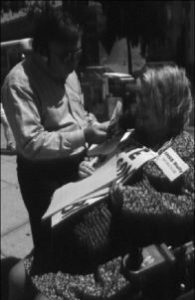Media coverage plays a crucial role in educating the public on disability issues. It could–and should–be helping people understand that these are civil-rights issues. But more often than not, reporting on disability perpetuates negative stereotypes or fails to tell the story from the perspective of people with disabilities.
Disability activists are devoting increasing energy to breaking a cycle of coverage that portrays people with disabilities as inspirational “human interest” stories isolated from any social context, or as people whose demands for “special” access inconvenience businesses. “There’s a lot of focusing on the individual people, stories of achievement–overcomer stories is what we call them,” says Mary Johnson, editor of cross-disability publication The Ragged Edge. “Or you’ll see what we’d call plight stories, where it’s about an individual who has some problem. When we do see stories about disability issues, they’re often not put in any larger context of the disability rights movement, so they’re always like a single story, and it’s almost as if the reporter doesn’t know that there is a disability rights movement, or history, or context.”
Take, for example, a Mother’s Day article in the San Francisco Chronicle: “Motherly Love: Together, Oakland Women and Son Confront and Conquer Obstacles” (5/7/99). Written to create “warm and fuzzy” feelings, it describes how a young boy helps his disabled mother: “Brandon, 9, feeds Monique, 34, when they go out to eat, opens doors for her, helps her dress and pushes every elevator button because his mother has had cerebral palsy since birth.” By focusing on the son’s caregiver role and on the pair’s warm relationship, the reporter at once creates a feeling of pity for the family, encourages readers to feel grateful that they don’t have this life, and fails to address the fact that it doesn’t have to be this way. The real–unaddressed–issue is, why does Brandon have to compensate for the lack of accessible doors, elevators, and in-home attendant services?
“They [the mainstream media] see our disabilities, our individual struggles with adversity, but refuse to see that the adversity is largely manufactured by society,” says Barry Corbet, editor of New Mobility, a national physical disability magazine. “They see that disability is tough, but not why it’s tough. They don’t see how so much of the difficulty could be easily mitigated by an enlightened policy.”
This blinkered perspective is also prevalent in coverage of policy and access issues. Johnson observes that reporters “don’t see the ADA as a civil rights law; they see it as a benefits law, like Social Security, where you get to be eligible for Medicare or eligible to have a parking space. The ADA is a civil rights law, and anybody should be able to use this civil rights law if they’ve been discriminated against.”
Another common problem in reporting on people with disabilities is the lack of sources who speak from a disability rights perspective.
An example of this is a June 22, 1999, San Francisco Examiner story about the recent Supreme Court rulings on the Americans with Disabilities Act. Headlined “Victory for Employers,” the story quotes Stephen Bokat, general counsel for the U.S. Chamber of Commerce, and the opinions of Justices Sandra Day O’Connor and Ruth Bader Ginsburg. That’s it. No quotes from disability rights organizations or lawyers. The story gives a full airing to the business perspective, but ignores the perspective of the nearly 54 million disabled people who are also affected.
Reporters often talk with service providers or national organizations run by people who don’t have disabilities, but seldom consult the real experts–people with disabilities and organizations run by them. This not only can result in inaccuracy and support for bad public policy, but also robs media audiences of an essential perspective and infantilizes people with disabilities–as if they were incapable of speaking for themselves.
Such common reporting flaws fit into a larger framework of cultural norms and stereotypes about disability. Reporters have been exposed to disability in the same way as the general public, notes Tari Susan Hartman, president of EIN SOF Communications, a public relations firm specializing in disability. So “it’s not surprising that reporters reflect the same prejudices that we find in the general public,” she says, adding that, unfortunately, reporters have the power to perpetuate as well as shatter myths and stereotypes.
“Generally, the mainstream press sees us as a largely irrelevant underclass that can only be described in polar terms of admiration or pity,” says Corbet. “Admiration because we live with what they think they could not; pity because they perceive our quality of life to be so low.”
Jennifer Burnett, a media-outreach volunteer with the grassroots disability organization ADAPT, sees “personal prejudice, fear of the unknown, and a discomfort with disabilities” as primary barriers to good reporting. “Some of [the reporters] come right to me because I’m able-bodied and I’m holding the folders. I’ll say, ‘let me get somebody who can talk to you.’ They don’t want to talk to that person. That person’s not pretty enough . . . or is drooling or can’t speak clearly.”
Changing these attitudes and the coverage that results from them is becoming a priority in the disability community, which has generated at least two new organizations devoted to media work. The San Diego-based Center for an Accessible Society was established to build relationships with the national media and publicize research on independent living. And in San Francisco, the nonprofit Disability Media Project is beginning to work with local media and develop a curriculum for journalism students. In addition, the President’s Committee on Employment of People with Disabilities has published The Disability Messenger, a guide providing tips for journalists on covering disability news.
Disability is a natural part of life–it’s the barriers that people and society erect that are the problem. And it’s time our media reflected this truth.
Resources for Reporters and Activists
For further information contact the following organizations:
ADAPT
www.adapt.org
Jennifer Burnett
(717) 238-0172
JBPCCD@aol.com
The Center for an Accessible Society
2980 Beech Street, San Diego, CA 92102
www.accessiblesociety.org
Bill Stothers, Deputy Director
(619) 232-2727
wstothers@accessiblesociety.org
Disability Media Project
P.O. Box 22115, San Francisco, CA 94122-0115
www.dmedia.org (website in development)
Suzanne Levine
phone: (415) 387-0617
fax: (415) 387-0583
suzanne@dmedia.org
Disability Rights Education & Defense Fund
2212 6th Street, Berkeley, CA 94710
www.dredf.org
Ken Stein
(510) 644-2555
The Disability Messenger
President’s Committee on Employment of People with Disabilities
1331 F Street, N.W. Ste. 300
Washington, DC 20004
www.pcepd.gov
Dina Dorich, Director of Public Affairs
(202) 376-6200 ext. 23
Dorich-Bernadine@pcepd.gov
EIN SOF Communications
6380 Wilshire Blvd. Suite 125, LA, CA 90048
Tari Susan Hartman
phone: (310) 578-5955
fax: (310) 578-6065
einsoftsh@aol.com
Independent Living Resource Center
649 Mission Street, 3rd Floor,
San Francisco, CA 94105
Herb Levine or Cathy Yuel
phone: (415) 543-6222
fax: (415) 543-6318
ilrcsf@earthlink.net
New Mobility Magazine
No Limits Communications Inc.
P.O. Box 220, Horsham, PA 19044
www.newmobility.com
Barry Corbet
phone: (888) 850-0344
fax: (303) 526-2879
bcorbet@rmi.net
Ragged Edge
Box 145, Louisville, KY 40201
www.ragged-edge-mag.com
Mary Johnson
phone: (502) 894-9492
EdgeMag@aol.com
Photo © 1998 Suzanne C. Levine
Peggy Coster talks with reporter at 1998 rally for livable wages for in home support service workers.
Suzanne C. Levine is the founder and executive director of the Disability Media Project. She is a freelance photographer who works primarily with the disability rights community.




I’m disabled. Chemically burned eyes. I’ve been disabled since 2004.
I lost everything — my home, my life’s savings, and my health — because I needed (and asked) to be able to sleep in my first-ever, brand new home in Colorado:
http://nbeener.blogspot.com/2014/11/the-destruction-of-medically-disabled.html
OR: Google Destruction of a Disabled Man in Colorado
I’m looking for a disability-savvy journalist interested in telling my story. I’m looking for help in raising awareness that “disabled” doesn’t automatically mean “uses a wheelchair.”
Do you know anybody ?
My sincere thanks,
Neil Brooks